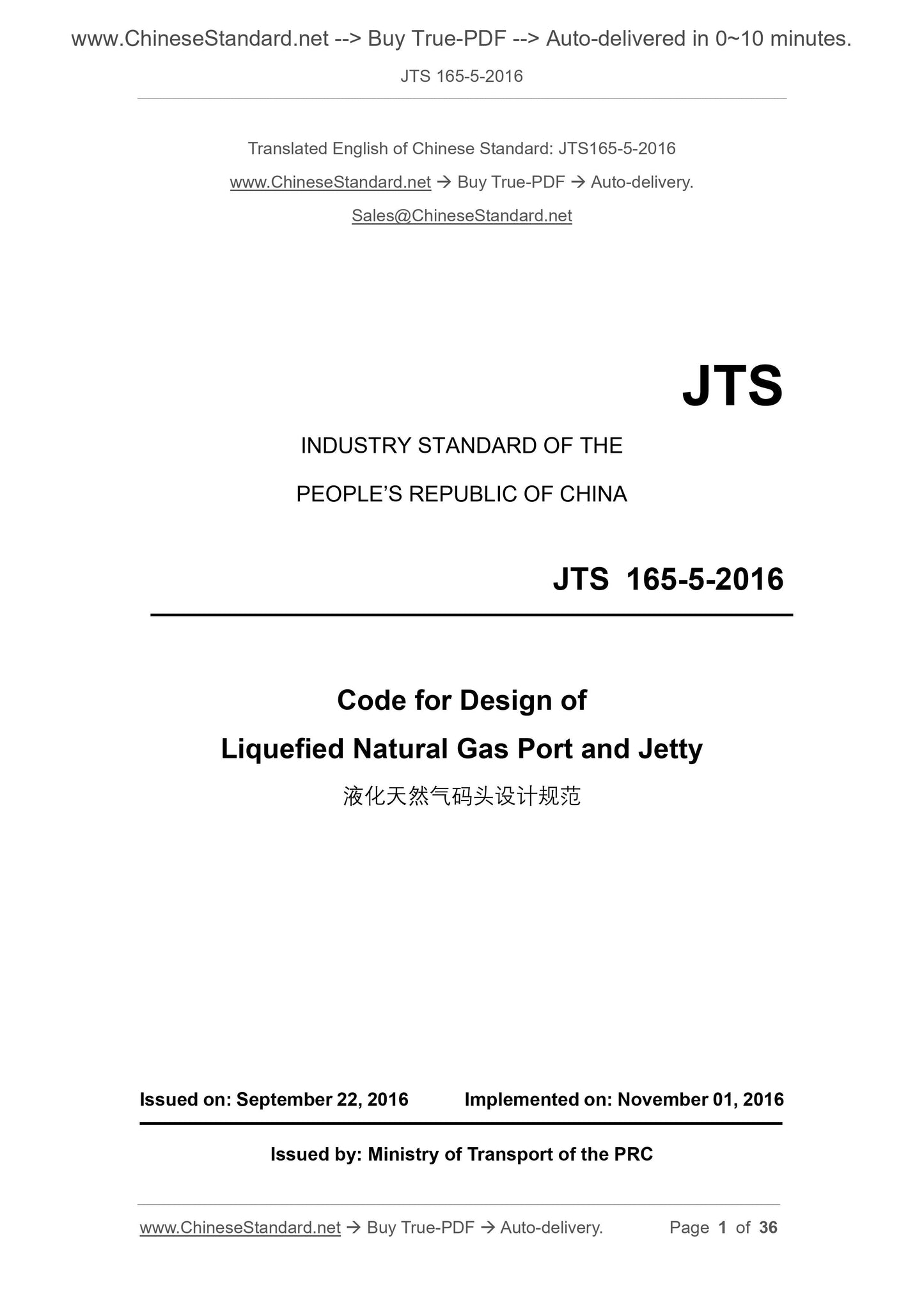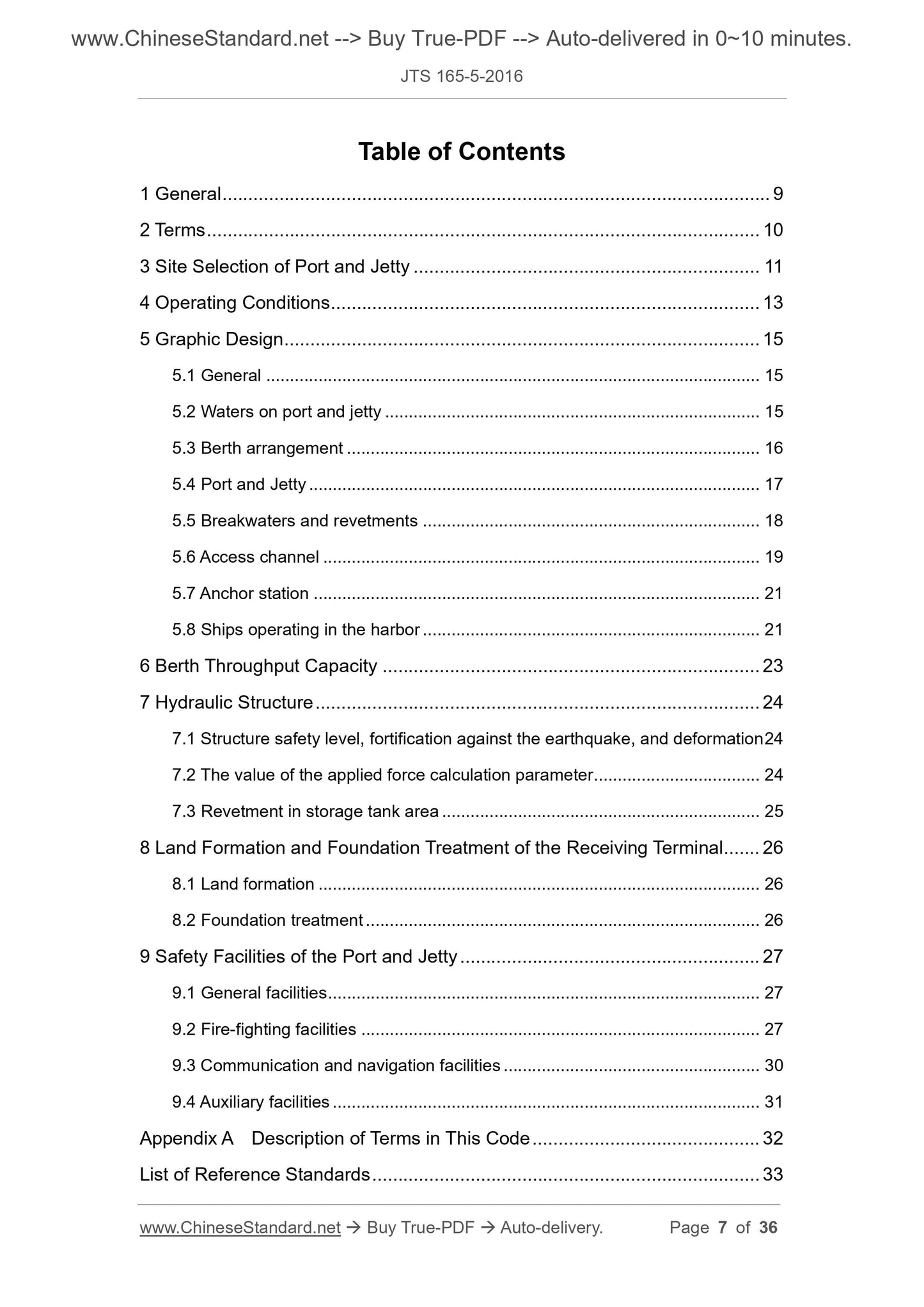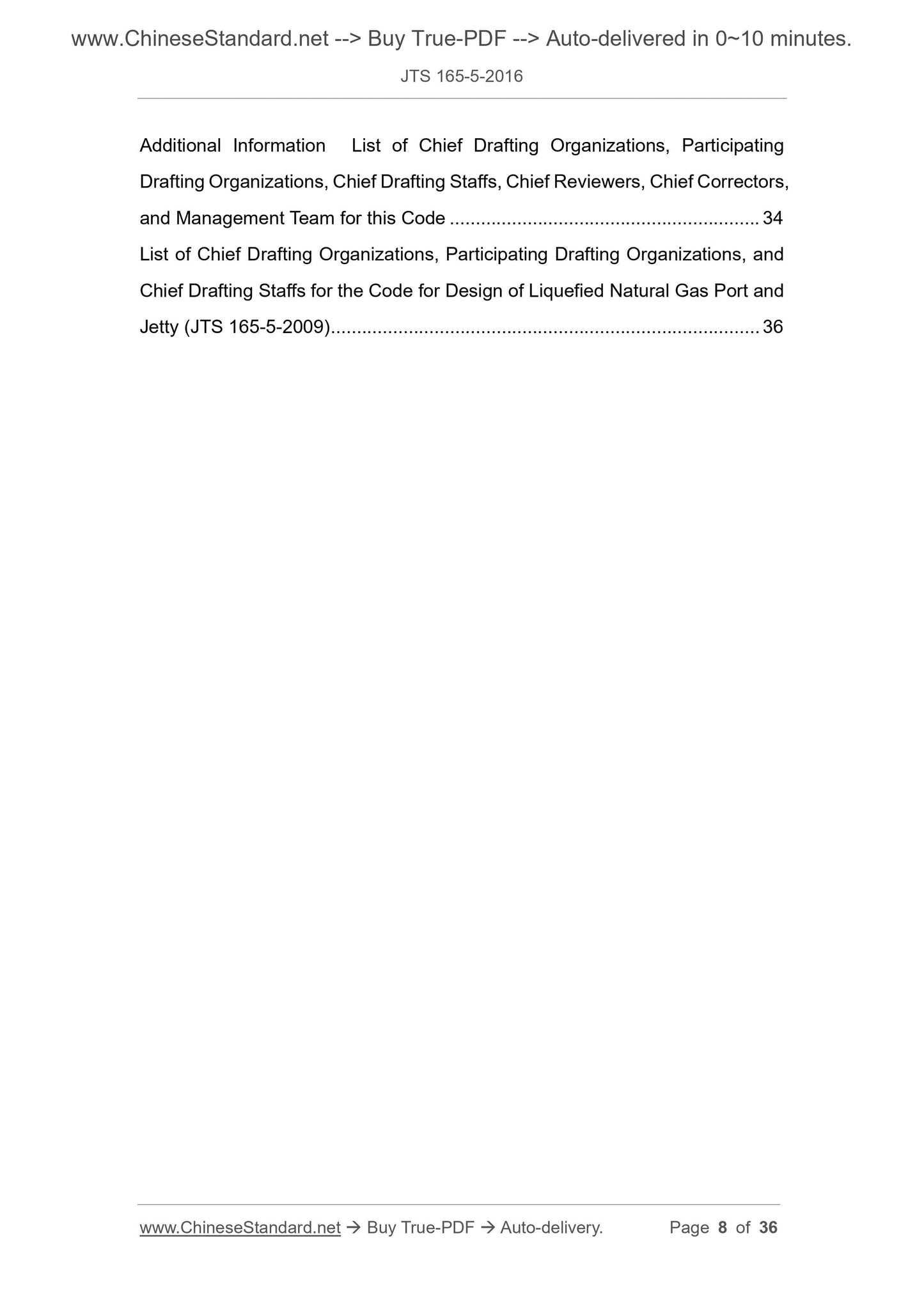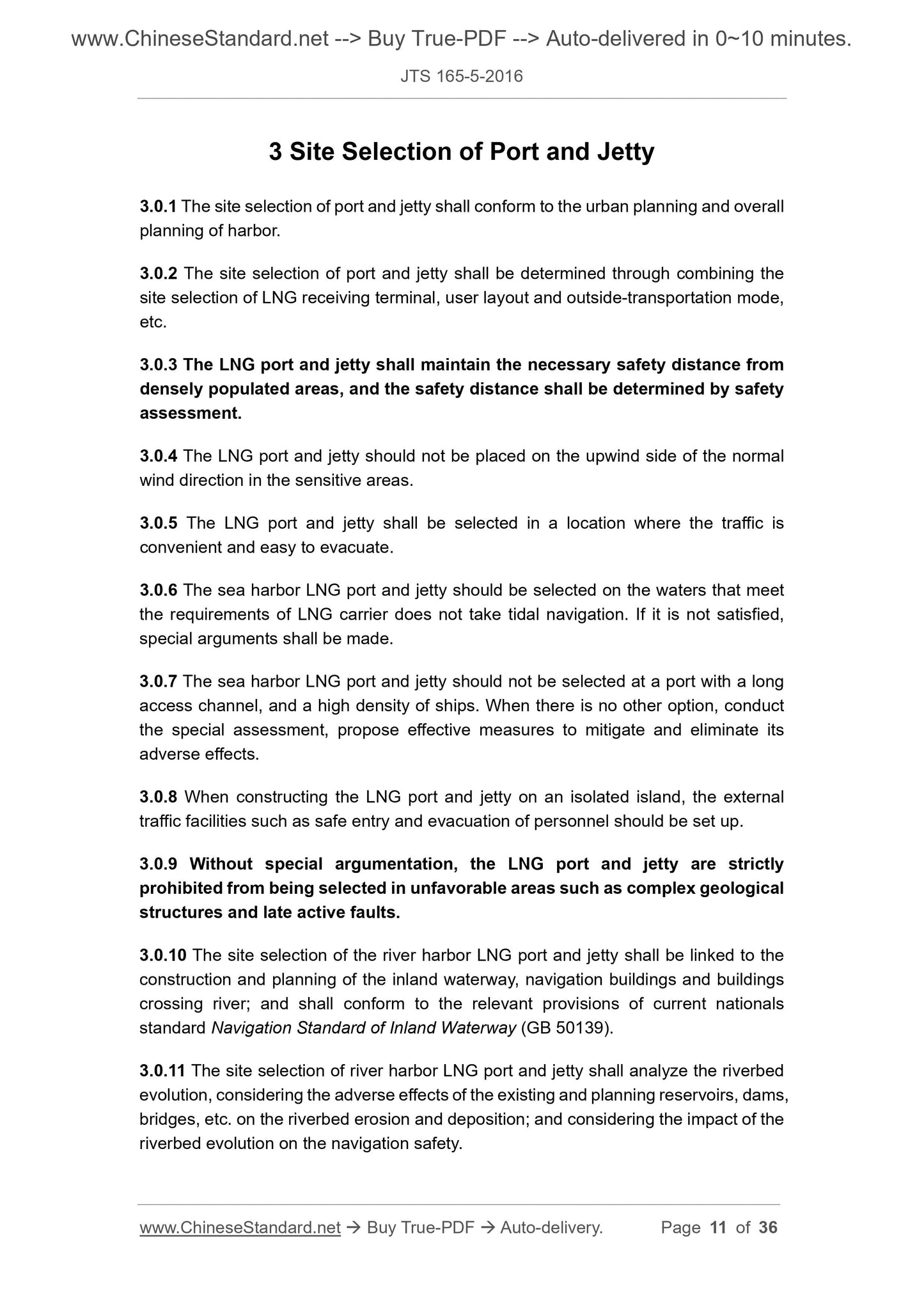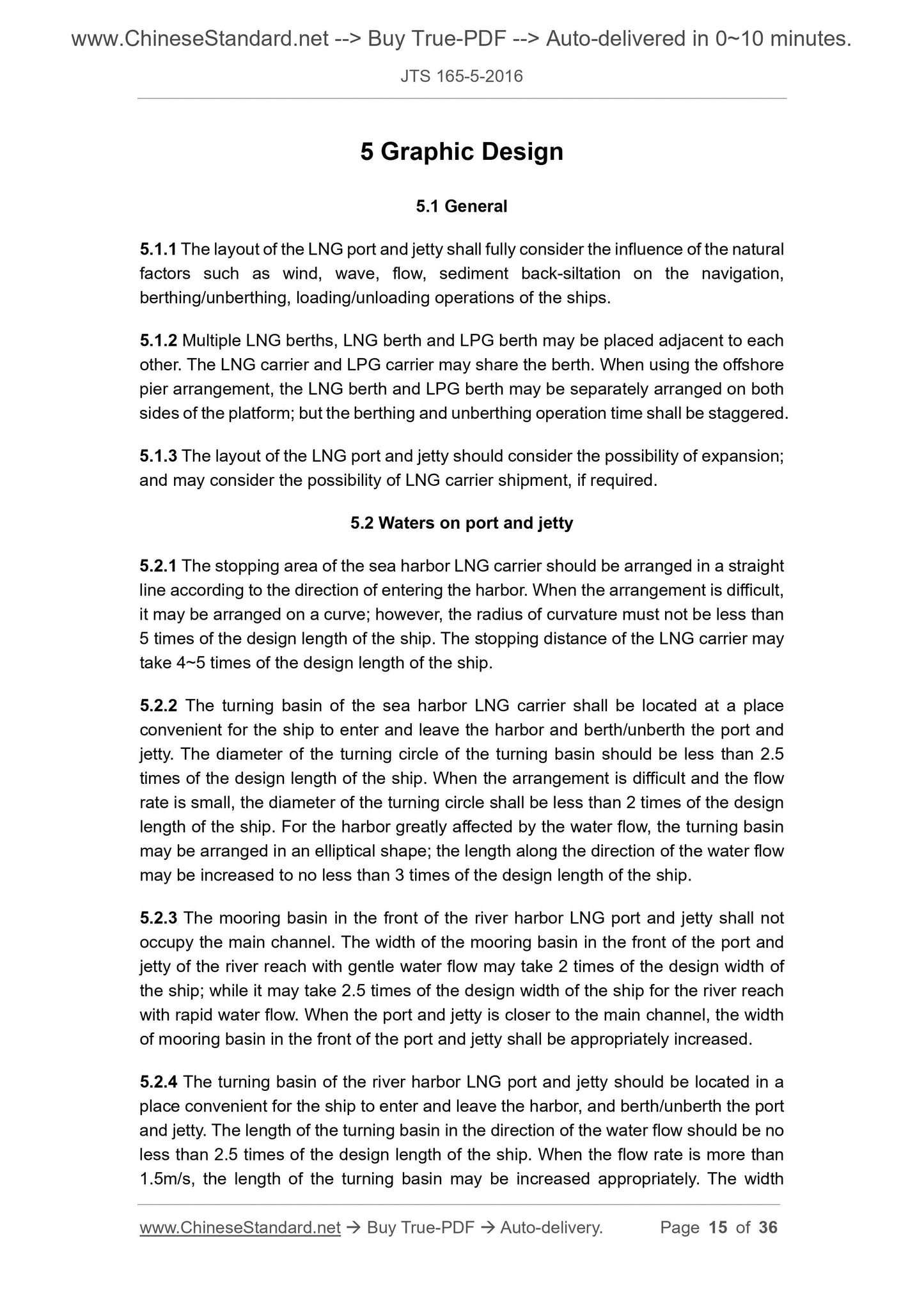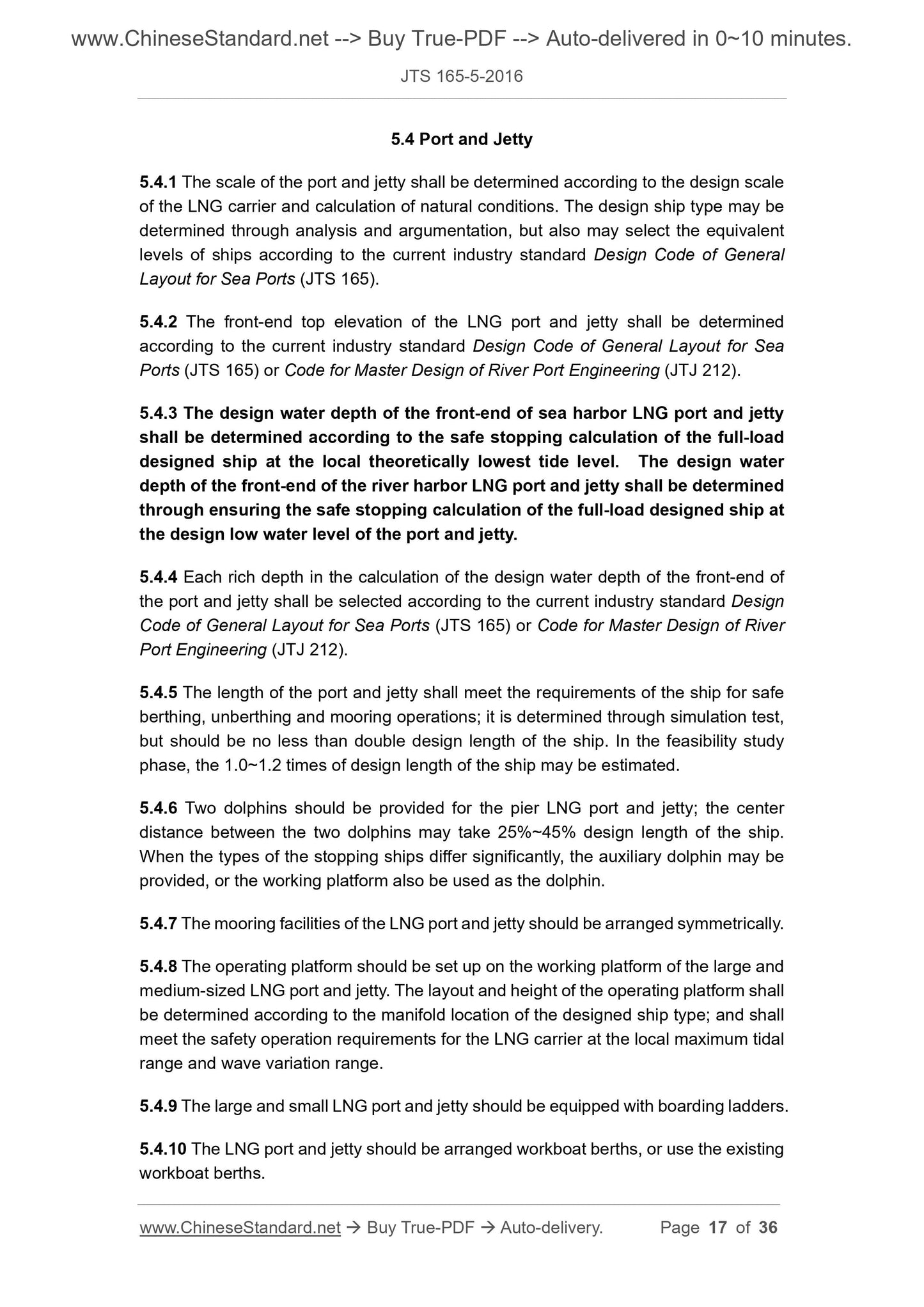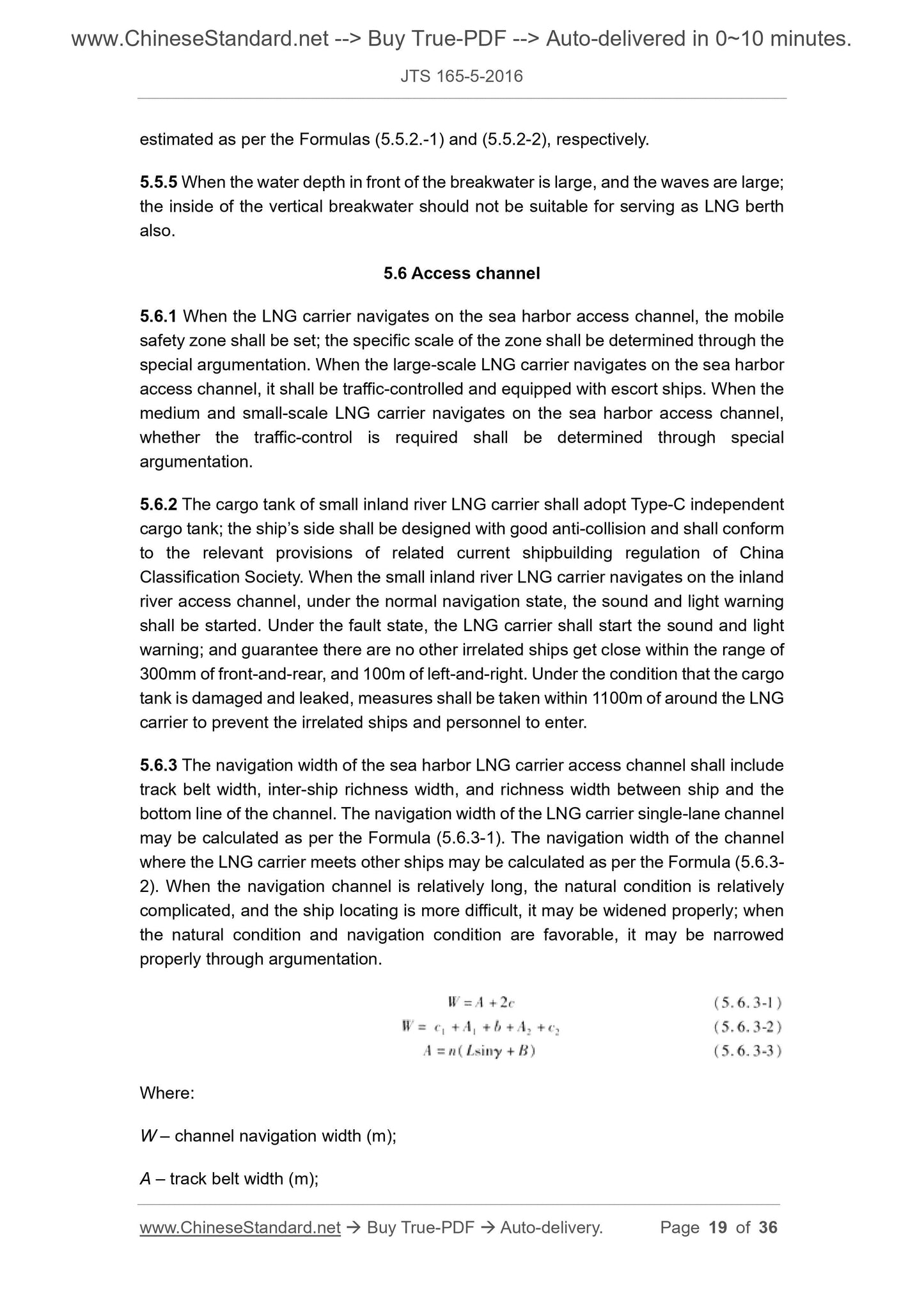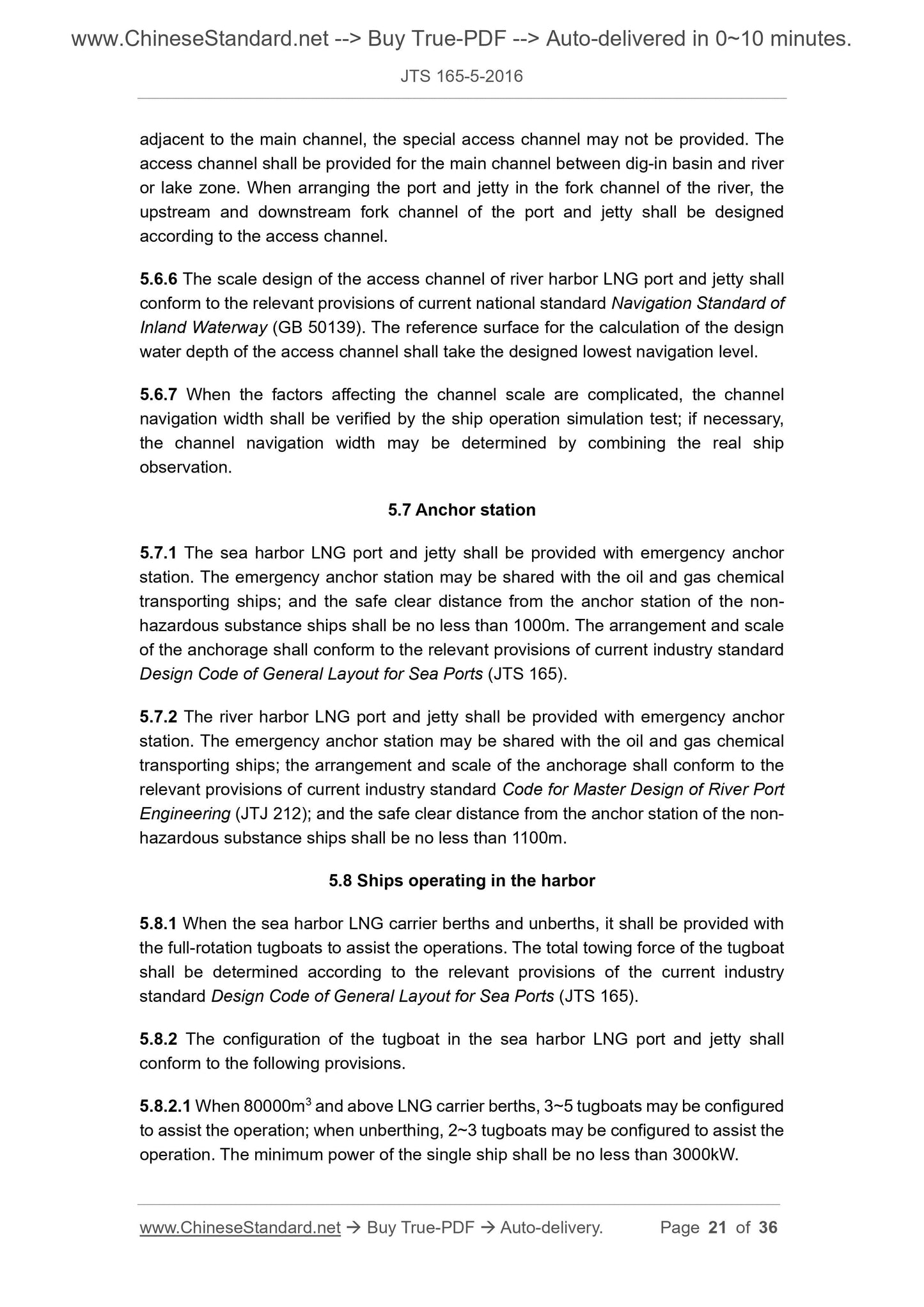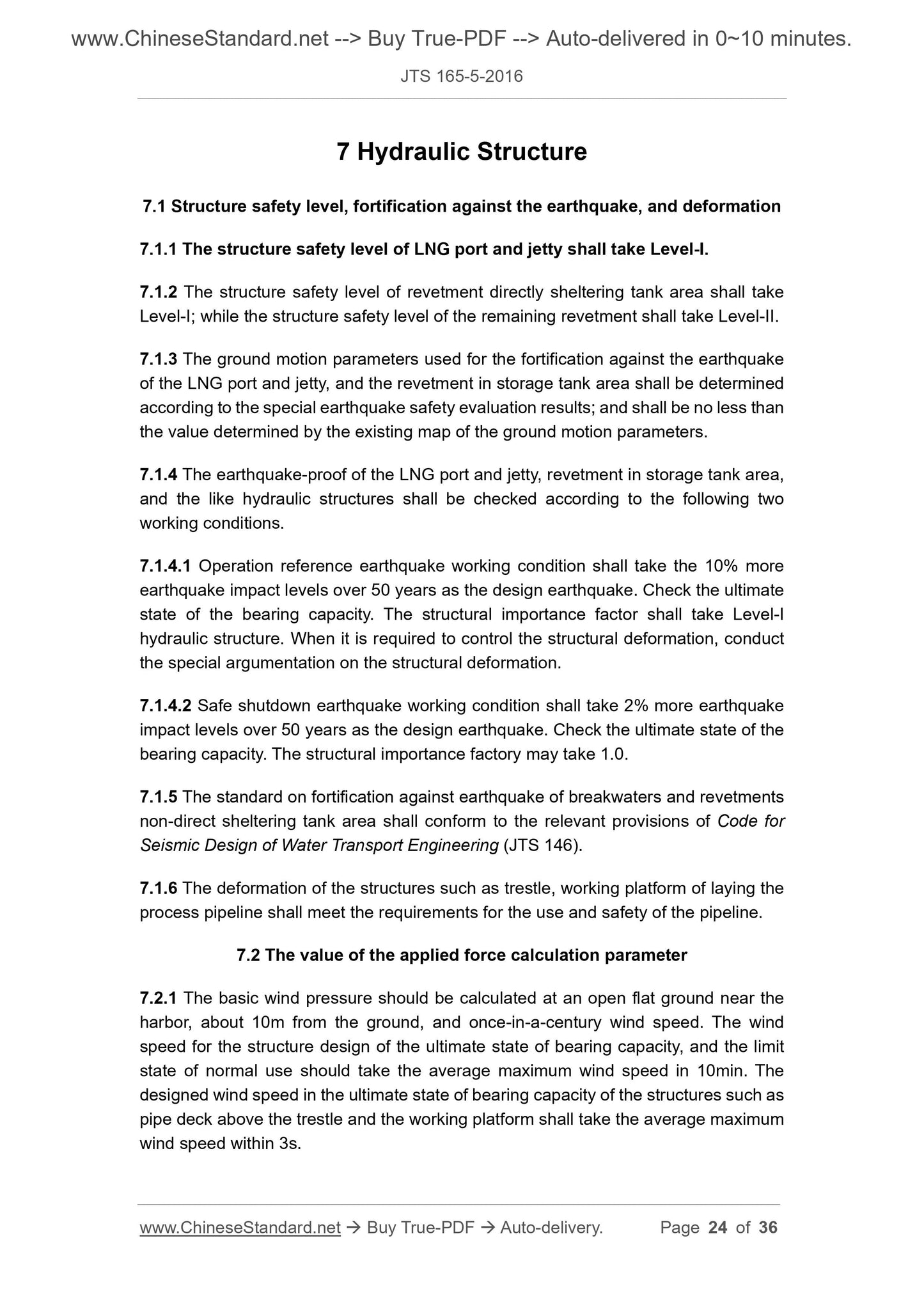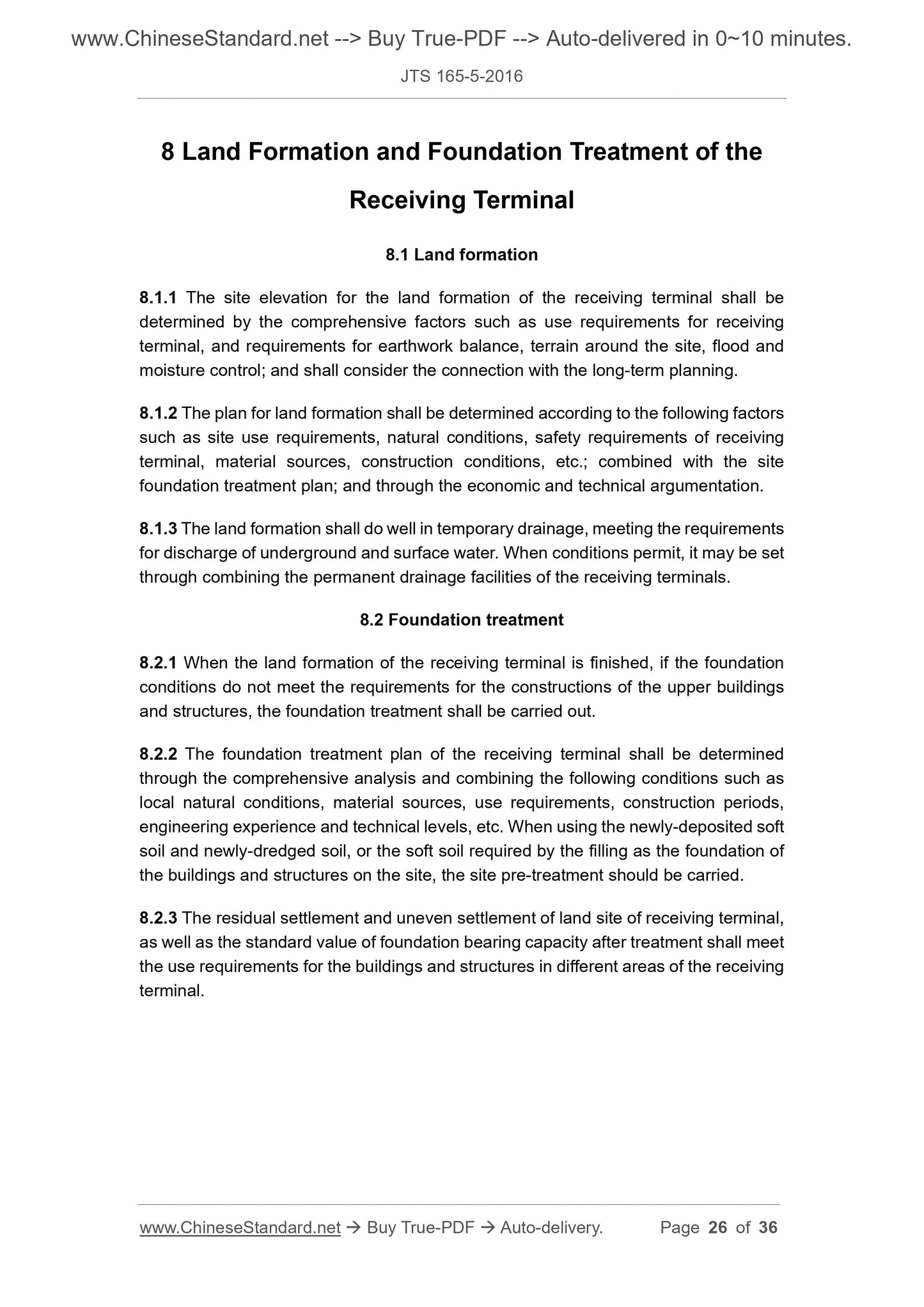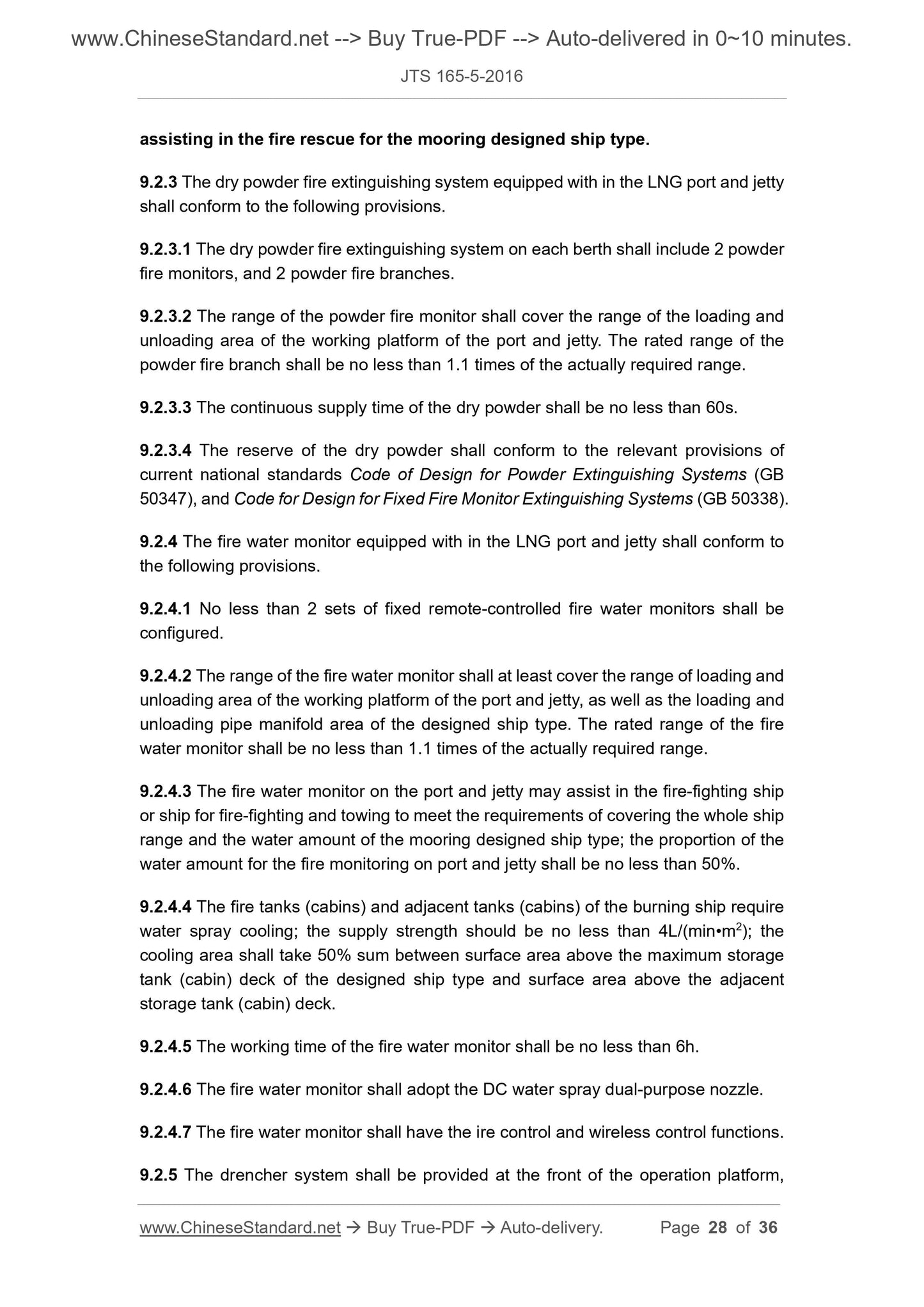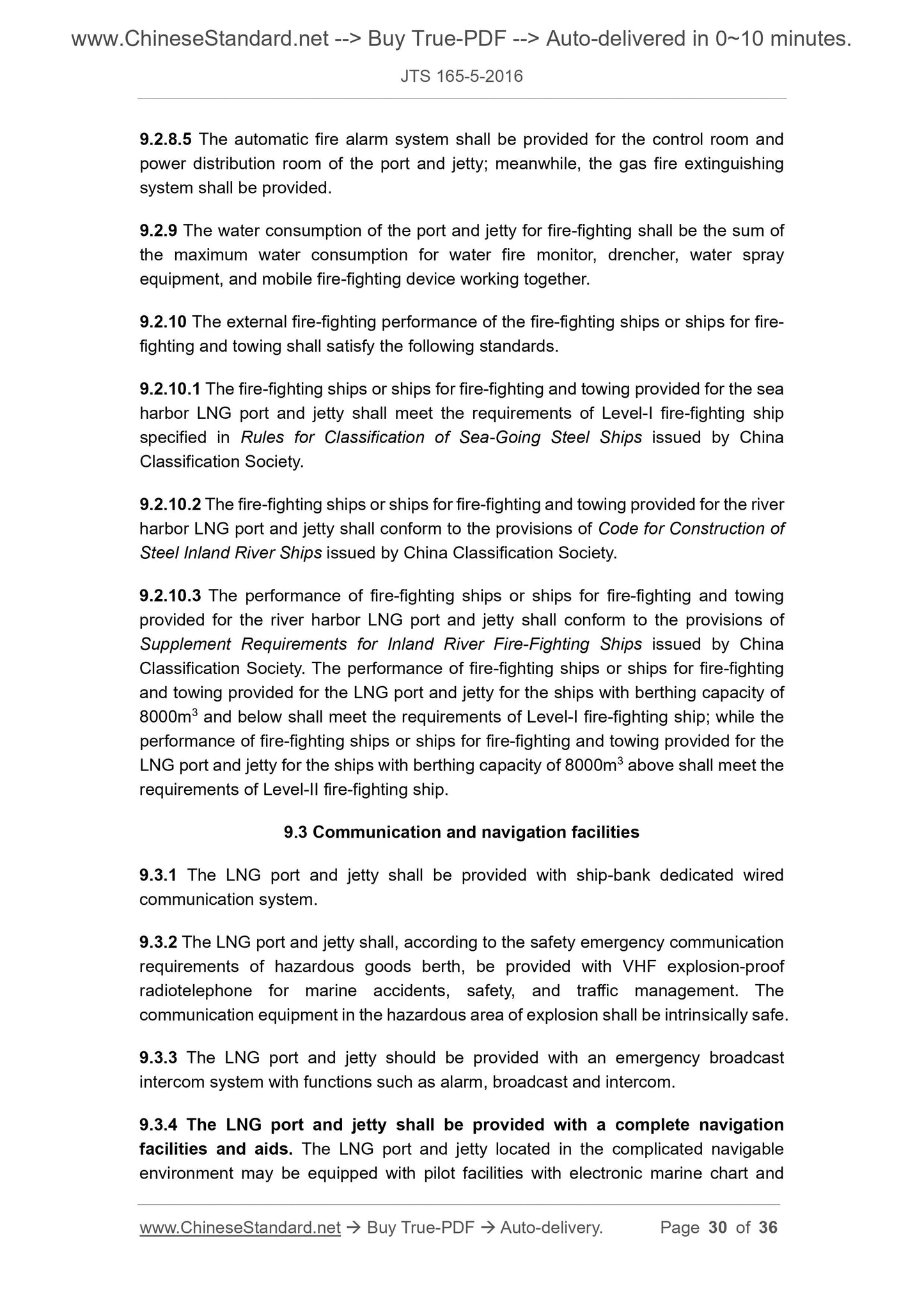1
/
of
12
PayPal, credit cards. Download editable-PDF and invoice in 1 second!
JTS 165-5-2016 English PDF (JTS165-5-2016)
JTS 165-5-2016 English PDF (JTS165-5-2016)
Regular price
$460.00 USD
Regular price
Sale price
$460.00 USD
Unit price
/
per
Shipping calculated at checkout.
Couldn't load pickup availability
Delivery: 3 seconds. Download true-PDF + Invoice.
Get QUOTATION in 1-minute: Click JTS 165-5-2016
Historical versions: JTS 165-5-2016
Preview True-PDF (Reload/Scroll if blank)
JTS 165-5-2016: Code for Design of Liquefied Natural Gas Port and Jetty
JTS 165-5-2016
INDUSTRY STANDARD OF THE
PEOPLE’S REPUBLIC OF CHINA
Code for Design of
Liquefied Natural Gas Port and Jetty
ISSUED ON: SEPTEMBER 22, 2016
IMPLEMENTED ON: NOVEMBER 01, 2016
Issued by: Ministry of Transport of the PRC
Table of Contents
1 General ... 9
2 Terms ... 10
3 Site Selection of Port and Jetty ... 11
4 Operating Conditions ... 13
5 Graphic Design ... 15
5.1 General ... 15
5.2 Waters on port and jetty ... 15
5.3 Berth arrangement ... 16
5.4 Port and Jetty ... 17
5.5 Breakwaters and revetments ... 18
5.6 Access channel ... 19
5.7 Anchor station ... 21
5.8 Ships operating in the harbor ... 21
6 Berth Throughput Capacity ... 23
7 Hydraulic Structure ... 24
7.1 Structure safety level, fortification against the earthquake, and deformation 24
7.2 The value of the applied force calculation parameter ... 24
7.3 Revetment in storage tank area ... 25
8 Land Formation and Foundation Treatment of the Receiving Terminal ... 26
8.1 Land formation ... 26
8.2 Foundation treatment ... 26
9 Safety Facilities of the Port and Jetty ... 27
9.1 General facilities ... 27
9.2 Fire-fighting facilities ... 27
9.3 Communication and navigation facilities ... 30
9.4 Auxiliary facilities ... 31
Appendix A Description of Terms in This Code ... 32
List of Reference Standards ... 33
Additional Information List of Chief Drafting Organizations, Participating
Drafting Organizations, Chief Drafting Staffs, Chief Reviewers, Chief Correctors,
and Management Team for this Code ... 34
List of Chief Drafting Organizations, Participating Drafting Organizations, and
Chief Drafting Staffs for the Code for Design of Liquefied Natural Gas Port and
Jetty (JTS 165-5-2009) ... 36
3 Site Selection of Port and Jetty
3.0.1 The site selection of port and jetty shall conform to the urban planning and overall
planning of harbor.
3.0.2 The site selection of port and jetty shall be determined through combining the
site selection of LNG receiving terminal, user layout and outside-transportation mode,
etc.
3.0.3 The LNG port and jetty shall maintain the necessary safety distance from
densely populated areas, and the safety distance shall be determined by safety
assessment.
3.0.4 The LNG port and jetty should not be placed on the upwind side of the normal
wind direction in the sensitive areas.
3.0.5 The LNG port and jetty shall be selected in a location where the traffic is
convenient and easy to evacuate.
3.0.6 The sea harbor LNG port and jetty should be selected on the waters that meet
the requirements of LNG carrier does not take tidal navigation. If it is not satisfied,
special arguments shall be made.
3.0.7 The sea harbor LNG port and jetty should not be selected at a port with a long
access channel, and a high density of ships. When there is no other option, conduct
the special assessment, propose effective measures to mitigate and eliminate its
adverse effects.
3.0.8 When constructing the LNG port and jetty on an isolated island, the external
traffic facilities such as safe entry and evacuation of personnel should be set up.
3.0.9 Without special argumentation, the LNG port and jetty are strictly
prohibited from being selected in unfavorable areas such as complex geological
structures and late active faults.
3.0.10 The site selection of the river harbor LNG port and jetty shall be linked to the
construction and planning of the inland waterway, navigation buildings and buildings
crossing river; and shall conform to the relevant provisions of current nationals
standard Navigation Standard of Inland Waterway (GB 50139).
3.0.11 The site selection of river harbor LNG port and jetty shall analyze the riverbed
evolution, considering the adverse effects of the existing and planning reservoirs, dams,
bridges, etc. on the riverbed erosion and deposition; and considering the impact of the
riverbed evolution on the navigation safety.
5 Graphic Design
5.1 General
5.1.1 The layout of the LNG port and jetty shall fully consider the influence of the natural
factors such as wind, wave, flow, sediment back-siltation on the navigation,
berthing/unberthing, loading/unloading operations of the ships.
5.1.2 Multiple LNG berths, LNG berth and LPG berth may be placed adjacent to each
other. The LNG carrier and LPG carrier may share the berth. When using the offshore
pier arrangement, the LNG berth and LPG berth may be separately arranged on both
sides of the platform; but the berthing and unberthing operation time shall be staggered.
5.1.3 The layout of the LNG port and jetty should consider the possibility of expansion;
and may consider the possibility of LNG carrier shipment, if required.
5.2 Waters on port and jetty
5.2.1 The stopping area of the sea harbor LNG carrier should be arranged in a straight
line according to the direction of entering the harbor. When the arrangement is difficult,
it may be arranged on a curve; however, the radius of curvature must not be less than
5 times of the design length of the ship. The stopping distance of the LNG carrier may
take 4~5 times of the design length of the ship.
5.2.2 The turning basin of the sea harbor LNG carrier shall be located at a place
convenient for the ship to enter and leave the harbor and berth/unberth the port and
jetty. The diameter of the turning circle of the turning basin should be less than 2.5
times of the design length of the ship. When the arrangement is difficult and the flow
rate is small, the diameter of the turning circle shall be less than 2 times of the design
length of the ship. For the harbor greatly affected by the water flow, the turning basin
may be arranged in an elliptical shape; the length along the direction of the water flow
may be increased to no less than 3 times of the design length of the ship.
5.2.3 The mooring basin in the front of the river harbor LNG port and jetty shall not
occupy the main channel. The width of the mooring basin in the front of the port and
jetty of the river reach with gentle water flow may take 2 times of the design width of
the ship; while it may take 2.5 times of the design width of the ship for the river reach
with rapid water flow. When the port and jetty is closer to the main channel, the width
of mooring basin in the front of the port and jetty shall be appropriately increased.
5.2.4 The turning basin of the river harbor LNG port and jetty should be located in a
place convenient for the ship to enter and leave the harbor, and berth/unberth the port
and jetty. The length of the turning basin in the direction of the water flow should be no
less than 2.5 times of the design length of the ship. When the flow rate is more than
1.5m/s, the length of the turning basin may be increased appropriately. The width
5.4 Port and Jetty
5.4.1 The scale of the port and jetty shall be determined according to the design scale
of the LNG carrier and calculation of natural conditions. The design ship type may be
determined through analysis and argumentation, but also may select the equivalent
levels of ships according to the current industry standard Design Code of General
Layout for Sea Ports (JTS 165).
5.4.2 The front-end top elevation of the LNG port and jetty shall be determined
according to the current industry standard Design Code of General Layout for Sea
Ports (JTS 165) or Code for Master Design of River Port Engineering (JTJ 212).
5.4.3 The design water depth of the front-end of sea harbor LNG port and jett...
Get QUOTATION in 1-minute: Click JTS 165-5-2016
Historical versions: JTS 165-5-2016
Preview True-PDF (Reload/Scroll if blank)
JTS 165-5-2016: Code for Design of Liquefied Natural Gas Port and Jetty
JTS 165-5-2016
INDUSTRY STANDARD OF THE
PEOPLE’S REPUBLIC OF CHINA
Code for Design of
Liquefied Natural Gas Port and Jetty
ISSUED ON: SEPTEMBER 22, 2016
IMPLEMENTED ON: NOVEMBER 01, 2016
Issued by: Ministry of Transport of the PRC
Table of Contents
1 General ... 9
2 Terms ... 10
3 Site Selection of Port and Jetty ... 11
4 Operating Conditions ... 13
5 Graphic Design ... 15
5.1 General ... 15
5.2 Waters on port and jetty ... 15
5.3 Berth arrangement ... 16
5.4 Port and Jetty ... 17
5.5 Breakwaters and revetments ... 18
5.6 Access channel ... 19
5.7 Anchor station ... 21
5.8 Ships operating in the harbor ... 21
6 Berth Throughput Capacity ... 23
7 Hydraulic Structure ... 24
7.1 Structure safety level, fortification against the earthquake, and deformation 24
7.2 The value of the applied force calculation parameter ... 24
7.3 Revetment in storage tank area ... 25
8 Land Formation and Foundation Treatment of the Receiving Terminal ... 26
8.1 Land formation ... 26
8.2 Foundation treatment ... 26
9 Safety Facilities of the Port and Jetty ... 27
9.1 General facilities ... 27
9.2 Fire-fighting facilities ... 27
9.3 Communication and navigation facilities ... 30
9.4 Auxiliary facilities ... 31
Appendix A Description of Terms in This Code ... 32
List of Reference Standards ... 33
Additional Information List of Chief Drafting Organizations, Participating
Drafting Organizations, Chief Drafting Staffs, Chief Reviewers, Chief Correctors,
and Management Team for this Code ... 34
List of Chief Drafting Organizations, Participating Drafting Organizations, and
Chief Drafting Staffs for the Code for Design of Liquefied Natural Gas Port and
Jetty (JTS 165-5-2009) ... 36
3 Site Selection of Port and Jetty
3.0.1 The site selection of port and jetty shall conform to the urban planning and overall
planning of harbor.
3.0.2 The site selection of port and jetty shall be determined through combining the
site selection of LNG receiving terminal, user layout and outside-transportation mode,
etc.
3.0.3 The LNG port and jetty shall maintain the necessary safety distance from
densely populated areas, and the safety distance shall be determined by safety
assessment.
3.0.4 The LNG port and jetty should not be placed on the upwind side of the normal
wind direction in the sensitive areas.
3.0.5 The LNG port and jetty shall be selected in a location where the traffic is
convenient and easy to evacuate.
3.0.6 The sea harbor LNG port and jetty should be selected on the waters that meet
the requirements of LNG carrier does not take tidal navigation. If it is not satisfied,
special arguments shall be made.
3.0.7 The sea harbor LNG port and jetty should not be selected at a port with a long
access channel, and a high density of ships. When there is no other option, conduct
the special assessment, propose effective measures to mitigate and eliminate its
adverse effects.
3.0.8 When constructing the LNG port and jetty on an isolated island, the external
traffic facilities such as safe entry and evacuation of personnel should be set up.
3.0.9 Without special argumentation, the LNG port and jetty are strictly
prohibited from being selected in unfavorable areas such as complex geological
structures and late active faults.
3.0.10 The site selection of the river harbor LNG port and jetty shall be linked to the
construction and planning of the inland waterway, navigation buildings and buildings
crossing river; and shall conform to the relevant provisions of current nationals
standard Navigation Standard of Inland Waterway (GB 50139).
3.0.11 The site selection of river harbor LNG port and jetty shall analyze the riverbed
evolution, considering the adverse effects of the existing and planning reservoirs, dams,
bridges, etc. on the riverbed erosion and deposition; and considering the impact of the
riverbed evolution on the navigation safety.
5 Graphic Design
5.1 General
5.1.1 The layout of the LNG port and jetty shall fully consider the influence of the natural
factors such as wind, wave, flow, sediment back-siltation on the navigation,
berthing/unberthing, loading/unloading operations of the ships.
5.1.2 Multiple LNG berths, LNG berth and LPG berth may be placed adjacent to each
other. The LNG carrier and LPG carrier may share the berth. When using the offshore
pier arrangement, the LNG berth and LPG berth may be separately arranged on both
sides of the platform; but the berthing and unberthing operation time shall be staggered.
5.1.3 The layout of the LNG port and jetty should consider the possibility of expansion;
and may consider the possibility of LNG carrier shipment, if required.
5.2 Waters on port and jetty
5.2.1 The stopping area of the sea harbor LNG carrier should be arranged in a straight
line according to the direction of entering the harbor. When the arrangement is difficult,
it may be arranged on a curve; however, the radius of curvature must not be less than
5 times of the design length of the ship. The stopping distance of the LNG carrier may
take 4~5 times of the design length of the ship.
5.2.2 The turning basin of the sea harbor LNG carrier shall be located at a place
convenient for the ship to enter and leave the harbor and berth/unberth the port and
jetty. The diameter of the turning circle of the turning basin should be less than 2.5
times of the design length of the ship. When the arrangement is difficult and the flow
rate is small, the diameter of the turning circle shall be less than 2 times of the design
length of the ship. For the harbor greatly affected by the water flow, the turning basin
may be arranged in an elliptical shape; the length along the direction of the water flow
may be increased to no less than 3 times of the design length of the ship.
5.2.3 The mooring basin in the front of the river harbor LNG port and jetty shall not
occupy the main channel. The width of the mooring basin in the front of the port and
jetty of the river reach with gentle water flow may take 2 times of the design width of
the ship; while it may take 2.5 times of the design width of the ship for the river reach
with rapid water flow. When the port and jetty is closer to the main channel, the width
of mooring basin in the front of the port and jetty shall be appropriately increased.
5.2.4 The turning basin of the river harbor LNG port and jetty should be located in a
place convenient for the ship to enter and leave the harbor, and berth/unberth the port
and jetty. The length of the turning basin in the direction of the water flow should be no
less than 2.5 times of the design length of the ship. When the flow rate is more than
1.5m/s, the length of the turning basin may be increased appropriately. The width
5.4 Port and Jetty
5.4.1 The scale of the port and jetty shall be determined according to the design scale
of the LNG carrier and calculation of natural conditions. The design ship type may be
determined through analysis and argumentation, but also may select the equivalent
levels of ships according to the current industry standard Design Code of General
Layout for Sea Ports (JTS 165).
5.4.2 The front-end top elevation of the LNG port and jetty shall be determined
according to the current industry standard Design Code of General Layout for Sea
Ports (JTS 165) or Code for Master Design of River Port Engineering (JTJ 212).
5.4.3 The design water depth of the front-end of sea harbor LNG port and jett...
Share
